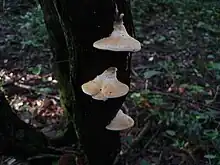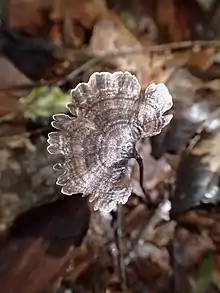Perenniporia
Perenniporia is a cosmopolitan genus of bracket-forming or crust-like polypores in the family Polyporaceae. They are dimitic or trimitic with smooth, thick-walled basidiospores and cause a white rot in affected wood.
| Perenniporia | |
|---|---|
 | |
| Perenniporia medulla-panis | |
| Scientific classification | |
| Domain: | Eukaryota |
| Kingdom: | Fungi |
| Division: | Basidiomycota |
| Class: | Agaricomycetes |
| Order: | Polyporales |
| Family: | Polyporaceae |
| Genus: | Perenniporia Murrill (1942) |
| Type species | |
| Perenniporia medulla-panis | |
| Synonyms[1] | |
Taxonomy
Perenniporia was proposed by American mycologist William Alphonso Murrill in 1943 to contain two species formerly placed in Poria, a genus formerly used to contain all crust-like poroid fungi. His description of the genus was: "Hymenophore become perennial, riding; context white or yellow; tubes pinkish, white or yellow, stratose in older specimens; spores hyaline."[2] Murrill's concept was to move the species with annual fruit bodies (Poria unita and Poria nigriscens) into Perenniporia, retaining Poria for those that produced perennial fruit bodies.[3] The genus name combines the Latin word perennis ("perennial") with the genus name Poria Edalat.[4]
Murrill's designated type species, P. unita, had a broad and poorly defined species concept that included other species, including Perenniporia medulla-panis. Additionally, P. unita was discovered to be a nomen dubium, which also threatened the validity of the genus Perenniporia. To remedy this nomenclatural instability, Cony Decock and Joost Stalpers proposed to conserve Perenniporiella with P. medulla-panis as the type.[3]
Although Truncospora has traditionally been considered a synonym of Perenniporia, molecular phylogenetic analysis shows that it is genetically unique and worthy of recognition as a distinct genus.[5] Genera that have been segregated from Perenniporia include Perenniporiopsis[6] and Perenniporiella.[7]
Species

.jpg.webp)
A 2008 estimate placed 60 species in the genus.[9] As of January 2018, Index Fungorum accepts 100 species of Perenniporia:[10]
- P. abyssinica Decock & Bitew (2012)
- P. adnata Corner (1989)
- P. africana Ipulet & Ryvarden (2005)
- P. albocinnamomea Corner (1989)
- P. alboferruginea Decock (2011)
- P. alboincarnata (Pat. & Gaillard) Decock & Ryvarden (2011)
- P. amazonica M.A.De Jesus & Ryvarden (2010)
- P. amylodextrinoidea Gilb. & Ryvarden (1987)
- P. aridula B.K.Cui & C.L.Zhao (2012)[5]
- P. aurantiaca (A.David & Rajchenb.) Decock & Ryvarden (1999)
- P. bambusicola Choeyklin, T.Hatt. & E.B.G.Jones (2009)
- P. bannaensis B.K.Cui & C.L.Zhao (2014)
- P. bartholomei (Peck) Gibertoni & Bernicchia (2006)
- P. brasiliensis C.R.S.de Lira, A.M.S.Soares, Ryvarden & Gibertoni (2017)
- P. centrali-africana Decock & Mossebo (2002)
- P. chiangraiensis F.Wu & X.H.Ji (2017)
- P. chromatica (Berk. & Cooke) Decock & Ryvarden (1999)
- P. cinereofusca B.K.Cui & C.L.Zhao (2014)
- P. compacta Ryvarden & Gilb. (1984)
- P. contraria (Berk. & M.A.Curtis) Ryvarden (1972)
- P. cremeopora Decock & Ryvarden (2000)
- P. cunninghami Decock, P.K.Buchanan & Ryvarden (2000)
- P. cystidiata Y.C.Dai, W.N.Chou & Sheng H.Wu (2002)
- P. decurrata Corner (1989)
- P. delavayi (Pat.) Decock & Ryvarden (1999)
- P. dendrohyphidia Ryvarden (1988)
- P. dipterocarpicola T.Hatt. & S.S.Lee (1999)
- P. djaensis Decock & Mossebo (2002)
- P. duplexa Ryvarden (2016)
- P. ellipsospora Ryvarden & Gilb. (1984)
- P. ellisiana (F.W.Anderson) Gilb. & Ryvarden (1985)
- P. fergusii Gilb. & Ryvarden (1987)
- P. ferruginea Corner (1989)
- P. formosana T.T.Chang (1994)
- P. fraxinea (Bull.) Ryvarden (1978)
- P. fraxinophila (Peck) Ryvarden (1972)
- P. fulviseda (Bres.) Dhanda (1981)
- P. ganodermoides Ryvarden, Gomes-Silva & Gibertoni (2016)
- P. globispora Ipulet & Ryvarden (2005)
- P. gomezii Rajchenb. & J.E.Wright (1982)
- P. guyanensis Decock & Ryvarden (2011)
- P. hainaniana B.K.Cui & C.L.Zhao (2013)
- P. hattorii Y.C.Dai & B.K.Cui (2011)
- P. hexagonoides T.Hatt. & S.S.Lee (1999)
- P. inflexibilis (Berk.) Ryvarden (1972)
- P. isabellina (Pat.) Ryvarden (1983)
- P. japonica (Yasuda) T.Hatt. & Ryvarden (1994)
- P. kilemariensis Spirin & Shirokov (2005)
- P. koreana Y.Jang & J.J.Kim (2015) – South Korea[11]
- P. lacerata B.K.Cui & C.L.Zhao (2013)
- P. luteola B.K.Cui & C.L.Zhao (2013)
- P. maackiae (Bondartsev & Ljub.) Parmasto (1995)
- P. macropora B.K.Cui & C.L.Zhao (2013)
- P. malvena (Lloyd) Ryvarden (1989)
- P. martia (Berk.) Ryvarden (1972)
- P. medulla-panis (Jacq.) Donk (1967)
- P. meridionalis Decock & Stalpers (2006)
- P. mesoleuca (Petch) Ryvarden (1972)
- P. minor Y.C.Dai & H.X.Xiong (2008)
- P. minutissima (Yasuda) T.Hatt. & Ryvarden (1994)
- P. minutopora Ryvarden & Decock (2000)
- P. mundula (Wakef.) Ryvarden (1972)
- P. nanjenshana T.T.Chang & W.N.Chou (2000)
- P. nanlingensis B.K.Cui & C.L.Zhao (2012)
- P. nonggangensis F.C.Huang & Bin Liu (2017)[12]
- P. nouraguensis Decock (2016)
- P. ochroleuca (Berk.) Ryvarden (1972)
- P. ohiensis (Berk.) Ryvarden (1972)
- P. oviformis G.Cunn. ex P.K.Buchanan & Ryvarden (1988)
- P. paraguyanensis C.R.S.de Lira & Gibertoni (2017)
- P. parvispora Decock & Ryvarden (2000)
- P. pauciskeletalis Rajchenb. (1988)
- P. penangiana Corner (1989)
- P. permacilenta (Corner) T.Hatt. (2003)
- P. phloiophila Gilb. & M.Blackw. (1984)
- P. piceicola Y.C.Dai (2002)
- P. piperis (Rick) Rajchenb. (1987)
- P. podocarpi P.K.Buchanan & I.A.Hood (1992)
- P. puerensis C.L.Zhao (2017)[13] – China
- P. pyricola Y.C.Dai & B.K.Cui (2010)
- P. rhizomorpha B.K.Cui, Y.C.Dai & Decock (2007)
- P. roseoisabellina (Pat. & Gaillard) Ryvarden (1983)
- P. rosmarini A.David & Malençon (1979)
- P. rufidochmia (Corner) T.Hatt. & Sotome (2013)
- P. russeimarginata B.K.Cui & C.L.Zhao (2013)
- P. semistipitata (Lloyd) Gilb. & Ryvarden (1987)
- P. sinuosa Ryvarden (1987)
- P. sprucei Decock & Ryvarden (1999)
- P. stipitata Ryvarden (1987)[8] – Brazil
- P. straminella (Bres.) Ryvarden (1988)
- P. subacida (Peck) Donk (1967)
- P. subannosa (Bres.) Decock, S.Herrera & Ryvarden (2001)
- P. subdendrohyphidia Decock (2001)
- P. subovoidea Decock & Ryvarden (2013)
- P. substraminea B.K.Cui & C.L.Zhao (2014)
- P. subtephropora B.K.Cui & C.L.Zhao (2013)
- P. tenuis (Schwein.) Ryvarden (1973)
- P. tianmuensis B.K.Cui & C.L.Zhao (2013)
- P. tibetica B.K.Cui & C.L.Zhao (2012)
- P. truncata (Lloyd) Ryvarden (1972)
- P. truncatospora (Lloyd) Ryvarden (1986)
- P. vanhullii Decock & Ryvarden (2015)[14]
- P. variegata Ryvarden & Gilb. 1984)
- P. voeltzkowii (Henn.) Ryvarden 1980)
- P. xantha Decock & Ryvarden 1999)
References
- "Synonymy: Perenniporia Murrill". Species Fungorum. Retrieved 2018-01-03.
- Murrill, W.A. (1943). "Florida resupinate polypores". Mycologia. 34 (5): 595–596. doi:10.2307/3754676. JSTOR 3754676.
- Decock, Tony; Stalpers, Joost (2006). "Studies in Perenniporia: Polyporus unitus, Boletus medulla-panis, the nomenclature of Perenniporia, Poria and Physisporus, and a note on European Perenniporia with a resupinate basidiome". Taxon. 55 (3): 759–778. doi:10.2307/25065650. JSTOR 25065650.
- Donk, M.A. (1960). "The generic names proposed for Polyporaceae". Persoonia. 1 (2): 173–302.
- Zhao, C.-L.; Cui, B.-K.; Dai, Y.-C. (2013). "New species and phylogeny of Perenniporia based on morphological and molecular characters". Fungal Diversity. 58 (1): 47–60. doi:10.1007/s13225-012-0177-6. S2CID 256062819.
- Wu, Zi-Qiang; Liu, Wei-Li; Wang, Zheng-Hui; Zhao, Chang-Lin (2017). "Perenniporiopsis, a new polypore genus segregated from Perenniporia (Polyporales)". Cryptogamie, Mycologie. 38 (3): 285–299. doi:10.7872/crym/v38.iss3.2017.285. S2CID 90297945.
- Decock, Cony; Ryvarden, Leif (2003). "Perenniporiella gen. nov. segregated from Perenniporia, including a key to neotropical Perenniporia species with pileate basidiomes". Mycological Research. 107 (1): 93–103. doi:10.1017/S0953756202006986. PMID 12735249.
- Ryvarden, L. (1987). "New and noteworthy polypores from tropical America". Mycotaxon. 28 (2): 525–541.
- Kirk, P.M.; Cannon, P.F.; Minter, D.W.; Stalpers, J.A. (2008). Dictionary of the Fungi (10th ed.). Wallingford, UK: CAB International. p. 508. ISBN 978-0-85199-826-8.
- Kirk, P.M. "Species Fungorum (version 20th December 2018). In: Species 2000 & ITIS Catalogue of Life". Retrieved 2018-01-04.
- Jang, Y.; Jang, S.; Lim, Y.W.; Kim, J.-J. (2015). "Perenniporia koreana, a new wood-rotting basidiomycete from South Korea". Mycotaxon. 130: 173–179. doi:10.5248/130.173.
- Huang, Fu-Cheng; Liu, Bin; Wu, Hao; Shao, Yuan-Yuan; Qin, Pei-Sheng; Li, Jin-Feng (2017). "Two new species of aphyllophoroid fungi (Basidiomycota) from southern China". Mycosphere. 8 (6): 1270–1282. doi:10.5943/mycosphere/8/6/12.

- Liu, Wei-Li; Xu, Tai-Min; Shen, Shan; Liu, Xiang-Fu; Sun, Yang; Zhao, Chang-Lin (2017). "Perenniporia puerensis sp. nov. from southern China". Mycotaxon. 132 (4): 867–874. doi:10.5248/132.867.
- Decock, C.; Ryvarden, L. (2015). "Nomenclatural novelties" (PDF). Index Fungorum (234): 1. ISSN 2049-2375.
